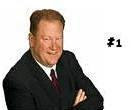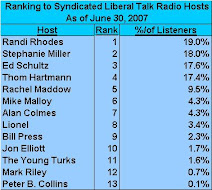The Liberal Talker Rankings
However, as we enter the New Year, you get the impression that the lib talk universe is going to change dramatically. There are several questions that will probably be answered in the coming weeks and months.
Will Air America Radio Network emerge from bankruptcy? And if yes, in what form?
Will Al Franken give up his prime AM slot on AAR and run for the U.S. Senate in Minnesota?
Will the Democratic Congress push for some changes in broadcast regulation, and reverse the trend towards deregulation?
TR will be covering, these and other issues in the coming weeks and months. However, before the landscape of the liberal talk hosts and liberal talk stations changes, we thought it would be interesting to present the year end rankings of all the syndicated talk show hosts.
Whatever, happens to lib talk in the coming year, it is very likely that syndication will continue to dominate the market. (Syndicated programming accounts over 90% of the hours of lib talk on radio.) However, somehow we suspect that the list of top syndicated lib talkers will be very different on December 31, 2007.
So we have put together listing* containing virtually all of the syndicated lib talkers who broadcast on weekdays. You will notice that the hosts are rated by the percentage of the total audience that they reach. Furthermore the positioning of the hosts is based on all radio listeners, not the so-called money demo, i.e. adults 25-49. You will have to go to other sources e.g. trade magazines or the host's websites to find specific data concerning ratings, shares, aqh's and cumes. Here is how the 17 syndicated hosts finished off 2006:


The number one lib talker is Ed Schultz. With about 100 affiliates, Schultz’ show is carried on 20 more stations than the number two talker, Al Franken (so it appears th
 at, the station clearance advantage, is the basis for Schultz’ slim 1.5% lead.). And now that Franken is sounding like he’s hanging up his microphone, it looks like we will have a new runner-up in the near future.
at, the station clearance advantage, is the basis for Schultz’ slim 1.5% lead.). And now that Franken is sounding like he’s hanging up his microphone, it looks like we will have a new runner-up in the near future.
Miller, who moved from tenth to fourth over the past year, doubled her affiliate count and easily had the fastest growing lib talk show. Despite reducing her show from four to three hours and losing some coverage, Randi Rhodes held on to third place in the survey. From what we hear, Randi's show does very well in money demo and she even beat Sean Hannity in that demo in key markets, including New York, throughout 2006.
AAR’s Sam Seder, led the second tier, closely trailed by Rachel
 Maddow. Thom Hartmann made an impressive surge from 2% to 5.2% in 2006. The iron made of lib talk, did this by increasing his ratings in Portland and increasing to his coverage to over a dozen stations. The remaining 11 syndicate talkers only accounted for 16% of people that listened to lib talk in 2006. Last place, in the survey is Nova M talker, Mike Malloy. This is because he has only a handful of affiliates and a lousy time period.
Maddow. Thom Hartmann made an impressive surge from 2% to 5.2% in 2006. The iron made of lib talk, did this by increasing his ratings in Portland and increasing to his coverage to over a dozen stations. The remaining 11 syndicate talkers only accounted for 16% of people that listened to lib talk in 2006. Last place, in the survey is Nova M talker, Mike Malloy. This is because he has only a handful of affiliates and a lousy time period. The battle of late night hosts was a three-way contest between Alan Colmes, Lionel, and Jon Elliott. Elliot wins this battle.The San Diego based host succeeded Mike Malloy, who was dumped by AAR three months ago. He appears to have secured the late night slot on the liberal talk network.
You may
Seven of the 17 syndicated talkers attracting 34.4% of lib talk r

A new survey will be released in early February and every three months thereafter.



*These estimates, pertaining to characteristics of the talk radio audience across America, are excerpted from Talking Radio’s in-house, non-scientific study. It is drawn from interviews with listeners of general news-talk radio across the United States supplemented by input from talk radio programmers, hosts, sales personnel, and radio station in-house research in addition to occasional studies provided by academic institutions.










1 comment:
A separate survey will published pretty show ranking local liberal talk hosts. Stay tuned
Post a Comment